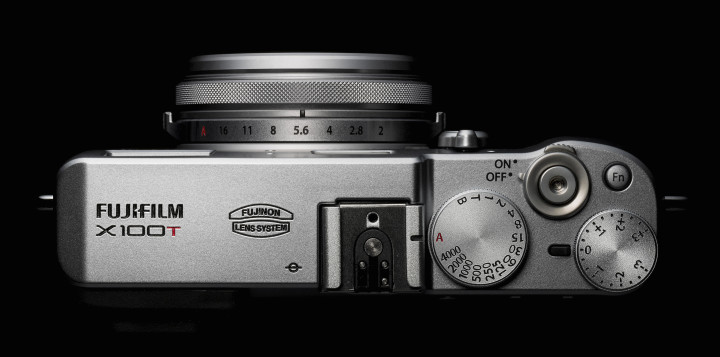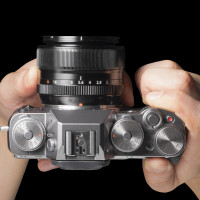Just six days before Photokina 2014 begins, Fujifilm has made the decision to announce what it looks like the new cameras and lenses we will see at the show. Unless they are keeping a few other announcements under wraps, I think we can say with almost 100% certainty that there won’t be any new sensors, more megapixels or a new X-Pro2 in 2014. But don’t let that get you down–there are some interesting updates that will surely pique your interest!
Fujifilm X100T: the X100s made perfect?

The first product to grab my attention was of course the Fujfilm X100T. I have been a huge fan of the X100 series since its birth, and the X100s is my favorite X camera as of today. Will the X100T become my new favourite X camera? Well, the updates seem interesting but as with the X30, it isn’t an entirely new camera. At its heart there is still the same 16MP X-Trans II sensor (the same as X100s, X-T1, X-E2), same high-speed EXR II processor and same 23mm f/2 fixed lens. The only difference between it and the X100s is the extended ISO that goes up to 51200. But it would be a mistake to think that there aren’t any other major improvements…

First, there is a new hybrid viewfinder, one of the unique characteristics of the X100 series and the X-Pro1. The viewfinder can be switched between electronic and optical. The electronic viewfinder is basically the same as the X100s but with a reduced time lag, an automatic brightness mode, better frame rate in low light and the possibility to disable film simulation previews (like the X30).
As for the optical viewfinder, there are some major improvements. Fuji has called it the first electronic rangefinder. The OVF can display an enlarged focus area at the bottom right of the finder and give you a real time preview of the focusing zone which is very useful for manual focusing. You can choose the magnification scale of this enlargement. Also, peaking and Digital Split Image can be selected. The new OVF is brighter and larger than the previous X100s and offers an improved Real Time Parallax correction that helps you create a good composition right away without the need to recompose after focusing. Also, the OVF can be used for movie recording.

Talking about video, the X100T has the same characteristics as the X30: various frame rates from 24fps to 60fps in Full HD, manual control for ISO, aperture and shutter speed, hybrid autofocus and the film simulation modes. Also included is the new “Classic Chrome” that is of course available for stills as well.
The X100T features the same built-in ND filter as the X100s but it also has an improved electronic shutter that not only offers a silent mode but can go up to 1/32000s. The two characteristics together offer great possibilities to shoot at the fastest aperture in bright daylight.

There are also improvements on the usability side: you can now select 1/3 stops directly on the aperture ring, and the button layout on the back has been redesigned. The drive button has been moved to the rear top right next to the black dial, and the arrow pad has been redesigned and looks like the one found on the X-T1 (hopefully with a better tactile experience).

The Q button is now on top of the arrow pad and there is a new Fn button that also activates Wifi. As you can imagine, the X100T also includes the same wireless capabilities of the X-T1. The LCD screen has now more resolution (1040k dots versus 460k dots). The X100T has 7 function buttons that can be customised. The Q Button also offers 16 individual settings that can be customised like the X30.
The camera looks almost identical to the X100s with some fine tuning to the design, especially concerning the two top dials and the focusing ring that have a new texture.
X100T vs. X100s
Here are all the improvements of the new model:
- New button layout on the rear
- Aperture ring now with 1/3 steps
- LCD screen: better resolution
- EVF: better time lag and frame rate in low light
- OVF: bigger with live view enlarged focus area and real time parallax correction
- Electronic shutter up to 1/32000s and completely silent
- Extended ISO up to 51200
- Classic Chrome film simulation mode
- Full HD video now with more frame rates and manual control
Is it worth upgrading?
Well, it’s hard to say until we can get our hands on a sample. What makes me really curious is to see the improvements on the optical viewfinder. I like the hybrid viewfinder of the X100s but in the end I mainly used the EVF, as the parallax issue often bothered me. If Fuji managed to concretely improve this, it might be something worth considering. The other updates are a nice addition but I don’t know if they merit an upgrade from the X100s. Certainly, an upgrade from the original X100 is a more reasonable possibility.
The X100T will be available in November 2014.
The Graphite Silver X-T1

The Fujfilm X-T1 sees a minor update that focuses primarily on its aesthetics– the addition of a three-layer coating that gives a highly resilient finish. The camera also features the previously-mentioned electronic shutter with a maximum speed of 1/32000s that also ensures a completely silent mode, the Classic Chrome film simulation mode and the possibility to see “raw colours and contrast” in the EVF instead of the film simulation modes. This special edition kit, which includes a leather strap and aluminium hot shoe cover, suggests that this new X-T1 is somehow a deluxe edition of the original X-T1 more than anything else, also because many of the enhanced features will be also available for the black X-T1 via a firmware update. They are:
- Direct selection of AF Area
- Unlocked AE-L/AF-L buttons
- Variable Focus Area during MF
- Direct selection of Macro mode
- Q Menu customization
- New video frame rates
- Manual shooting in Video mode
- Phase Detection AF support for Instant AF
- Interlocking of Metering and Focus areas
- Expansion of shutter speed in Program Shift mode
It also appears that the electronic shutter will be available for the original X-T1, so I see no reason to upgrade here if you already own the X-T1, unless your heart starts to flutter at the sight of the new graphite silver look! Personally, I really don’t like it if the official images below are a true reflection of its new appearance. It might look better in real life. Moreover, it looks mismatched when paired with the vertical battery grip.
The Fujinon XF 50-140mm F2.8 R LM OIS WR
The XF 50-140mm is perhaps the second most important announcement out of the four, as it offers an equivalent focal length of 76-213mm with a constant aperture of f/2.8, which is by default the standard telephoto zoom lens that professional photographers use for their work in various situations like weddings, events or even portraits.

The new lens construction includes 23 glass elements in 16 groups, five ED lens elements and one Super ED lens element with low dispersion characteristics to reduce chromatic aberrations. There is also a new Nano-GI (Gradient Index) coating technology that delivers high-performance optic results.

The lens doesn’t extend throughout the entire zoom range. It is weather and dust resistant and is also freeze proof down to -10°C. It has the same high-performance gyro sensor stabilisation system as the recent XF 18-135mm. The lens also features a new Inner Focusing mechanism with triple linear motors that ensure quieter focusing to be as discreet as possible.
The lens features an aperture ring and is made of metal with metal rings too. There is also a AF/MF switch on the side.
The XF 56mm F1.2 R APD

This new XF 56mm f/1.2 is a more “specialised” edition of the XF 56mm f/1.2 and has been designed especially for portrait photographers. It features a new apodizing filter that allows you to change the out-of-focus rendering. Specifically, it makes those out-of-focus areas smoother.
The apodization filter delivers the best results at the fastest apertures. There is an ND filter included that adjusts brightness in three levels to enable wide apertures to be used in bright environments. The lens features an aperture ring showing the effective F No. in red to indicate the apodizing effect. The difference between the F No. and the effective F No. indicates the how effective the apodization filter is.
According to the first reviews on the Internet, the lens is different from the twin 56mm also because it is less bright by one stop with the same aperture and only works with contrast detection AF, meaning it is likely to be slower than the standard XF 56mm. Of course the first reviews are based on a prototype so I will reserve judgement until I can try a sample myself.
What I can say is that it will surely be a special lens that portrait photographers can really appreciate for the possibility to control bokeh and out of focus zones. However, not everyone will consider that slight difference in image quality a good enough reason to upgrade.















